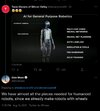RobsJester
Member
“Why Bots and what will they be used for?”
I have a theory - always Frame Elon’s endeavors as pieces to make human-life multi planetary
Try it, it’s a fun game: think of a feature of any Musk company and consider how it’s directly applicable to enabling life on Mars
Teslabot - In short, life on Mars will be exceedingly dangerous, and frankly, Mars will require expendable labor. Also, humans and life-support require a lot of room on a rocket - SpaceX can pack 50 times more 125lbs 5’ Teslabots per rocket
Boring/tunnels - the atmosphere on Mars is thin and surface is baked with solar radiation, Marian colonies will be subterranean. Thus the Boring Co
SolarCity - most viable way to Power Mars is solar. Winter will be very long and brutal on Mars, so Megapack & Stationary Storage
Starlink - clearly Cable and phone lines are nonexistent on Mars and the atmosphere may not be conducive for radio waves, requiring a planet-wide satellite Internet for colonies to communicate
Cybertruck Stainless Steel Exoskeleton - Starship uses the same grade of Stainless. Service Centers in various climates all over the world will note possible issues with stainless prior to launching the first reusable rockets to Mars.
Neural link - Mars will require our best and brightest, removing the finger/voice data bottleneck will increase productivity for the few colonists
Autopilot/FSD - labor on Mars will be scarce - vehicles will need to be autonomous
Ok, the theory does fall apart when considering sophomoric ideas like Fartmode and Snake-Jazz, but hey, everyone needs a little fun
To bookend for shareholders - the Q posed at the event is quite valid: is there a market for very expensive robots to replace low-waged labor? Perhaps not. But, I suspect Teslabot will be in development for years with limited impact on R&D. Initial delivery in late 2020’s to coincide with SpaceX first rockets to Mars - Teslabot production scaled lockstep with Starship production, and by mid-2030’s, SpaceX and Pentagon will buy the entire production run in perpetuity
I have a theory - always Frame Elon’s endeavors as pieces to make human-life multi planetary
Try it, it’s a fun game: think of a feature of any Musk company and consider how it’s directly applicable to enabling life on Mars
Teslabot - In short, life on Mars will be exceedingly dangerous, and frankly, Mars will require expendable labor. Also, humans and life-support require a lot of room on a rocket - SpaceX can pack 50 times more 125lbs 5’ Teslabots per rocket
Boring/tunnels - the atmosphere on Mars is thin and surface is baked with solar radiation, Marian colonies will be subterranean. Thus the Boring Co
SolarCity - most viable way to Power Mars is solar. Winter will be very long and brutal on Mars, so Megapack & Stationary Storage
Starlink - clearly Cable and phone lines are nonexistent on Mars and the atmosphere may not be conducive for radio waves, requiring a planet-wide satellite Internet for colonies to communicate
Cybertruck Stainless Steel Exoskeleton - Starship uses the same grade of Stainless. Service Centers in various climates all over the world will note possible issues with stainless prior to launching the first reusable rockets to Mars.
Neural link - Mars will require our best and brightest, removing the finger/voice data bottleneck will increase productivity for the few colonists
Autopilot/FSD - labor on Mars will be scarce - vehicles will need to be autonomous
Ok, the theory does fall apart when considering sophomoric ideas like Fartmode and Snake-Jazz, but hey, everyone needs a little fun
To bookend for shareholders - the Q posed at the event is quite valid: is there a market for very expensive robots to replace low-waged labor? Perhaps not. But, I suspect Teslabot will be in development for years with limited impact on R&D. Initial delivery in late 2020’s to coincide with SpaceX first rockets to Mars - Teslabot production scaled lockstep with Starship production, and by mid-2030’s, SpaceX and Pentagon will buy the entire production run in perpetuity



